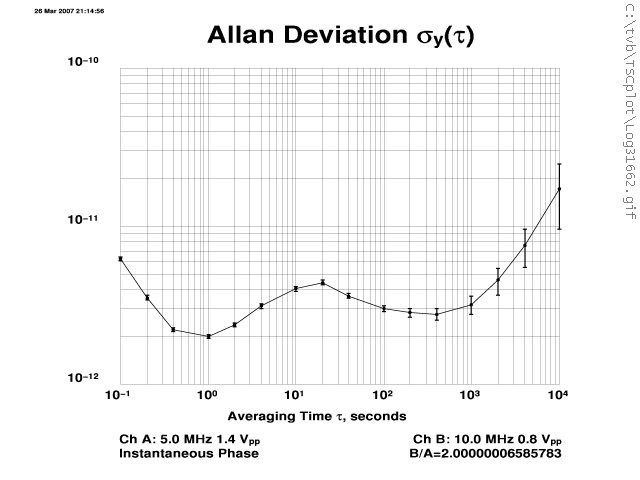
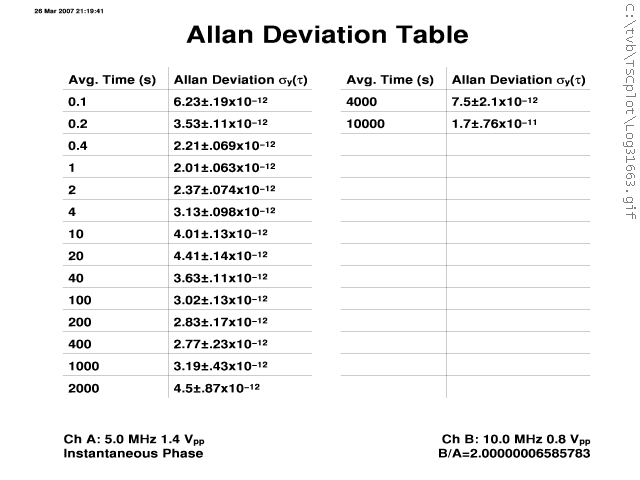
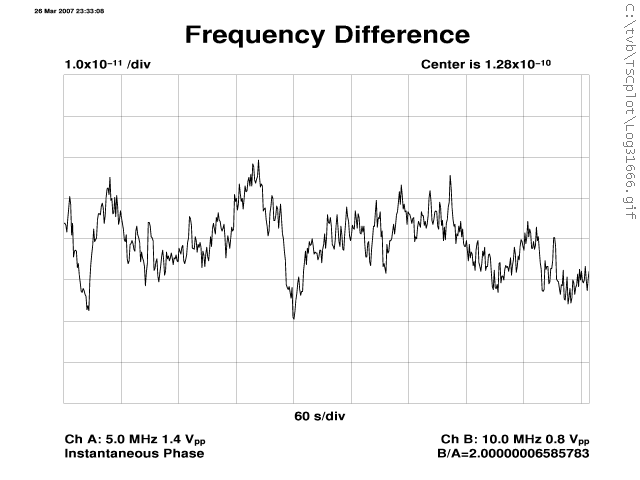
06-May-2007 Performance review of Fury GPSDO
Every few years a couple of old or new companies come up with a fresh GPSDO product. The "Fury" is a new, compact GPSDO (GPS Disciplined Oscillator) from Jackson Labs, a newcomer to the Time & Frequency market.
The Fury GPSDO is based on a Motorola M12+ GPS timing receiver, an SC-cut OCXO (Oven Controlled Crystal Oscillator), a standard microprocessor, a high-speed DSP to perform the conventional role of a phase comparator or time interval counter, and a precision, high-resolution DAC to electronically tune the quartz oscillator frequency (EFC). I haven't yet opened my Fury enclosure so I can't report exact part numbers.
A single push button scrolls through several status pages on a small 2 line 20 character LCD. There is a GPS antenna input (+5V powered), a 10 MHz RF output, a 1 PPS pulse output, and a RS-232 serial port. That's all; very basic.
The Motorola M12+ has long proved to be an excellent GPS timing receiver, with UTC-aligned, 1 PPS output. The purpose of all the rest of the ingredients in a GPSDO are to phase and/or frequency lock a 10 MHz oscillator to these precise GPS timing pulses. The result is both an accurate and low-jitter OCXO-derived 1PPS timing pulse (i.e., a time or time interval standard) and a stable, pure, and accurate 10 MHz RF signal (i.e., a frequency standard). Note that if all one needs is a long-term precision timing source and not a frequency source, then a GPS timing receiver board is all that's required.
I would include a photo of the Fury but due to the prototype nature of the unit I obtained, it's not a pretty picture. The firmware version is 0.98.6 (April 24 2007).
The Fury being tested here happened to be powered on for months without a GPS antenna attached. Below, then, is a measure of well-aged, unlocked performance (essentially the performance of the internal OCXO only).
What can be seen in the plots is 10-12 to 10-11 level of stability for all tau, short-term. There is a slight hump near tau 20 seconds, of unknown origin, which reduces performance by up to a factor of two. Otherwise the plot is typical of a well-aged, SC-cut OCXO and appears to be a good choice for this class of GPSDO.
 |
 |
 |
To measure long-term frequency drift one can forward extrapolate the +1 ADEV slope to tau 86.4k s (1 day), or just look at a frequency plot. The plots below are made from about 140k 1-second phase samples (about 40 hours total).
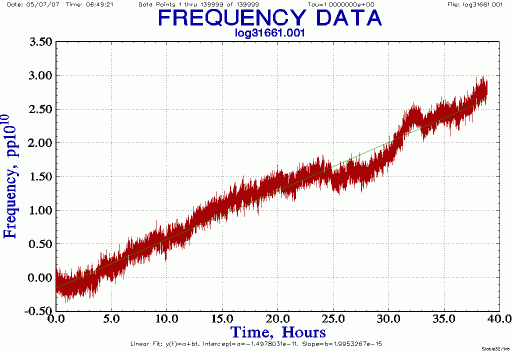
The main feature of this plot is the upward slope of frequency, indicating a frequency drift rate of +1.7×10-10 / day. The fit is quite good (the line is straight rather than curved) confirming that the drift rate is linear. Both the low rate and the linear shape are expected for an OCXO left running for months. I don't have the P/N of the OCXO nor its drift spec. But usually a OCXO performs much better than spec when left alone for weeks and months.
The plot also shows at least one frequency jump (a shift in the line) and several cases of small to medium variations in frequency drift rate (wiggles in the line). This is also normal for most OCXO.
Finally, the level of short-term noise is revealed by the thickness of the line; in this case approximately 0.5×10-10, or 5×10-11, peak to peak.
One conclusion already is that even without GPS, the Fury makes a nice low-drift 10 MHz quartz frequency standard.
Below is an Allan deviation plot for this 40 hour run:
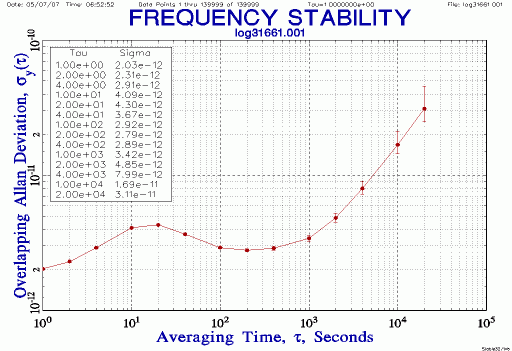
OK, that's enough free-running, GPS-unlocked measurements. Now let GPS do it's magic.
For this test, the Fury was warmed up for many days, new firmware was loaded, a GPS survey was initiated, and it was then given a further day to settle down. With all these ideal conditions completed, below are stability, phase, and frequency plots after the first day of continuous measurement.
| 110k samples (= 31.1 hours = 1.29 days) |
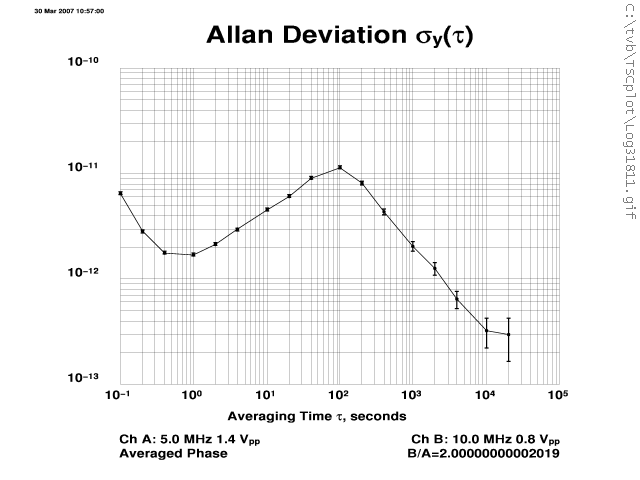 |
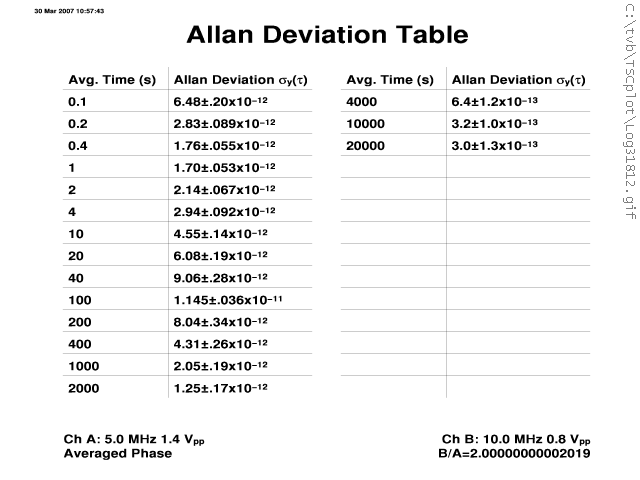 |
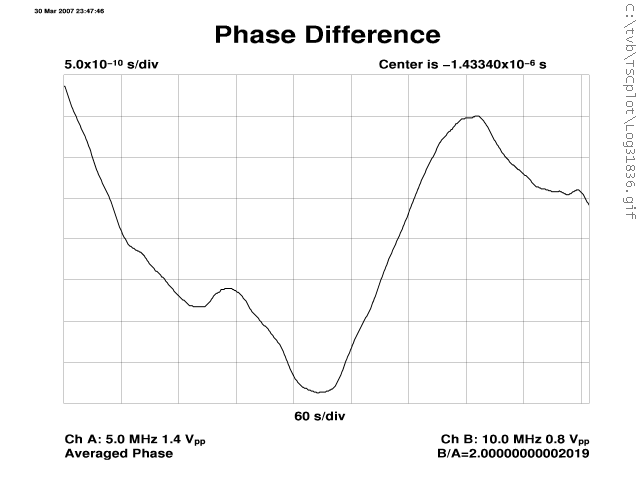 |
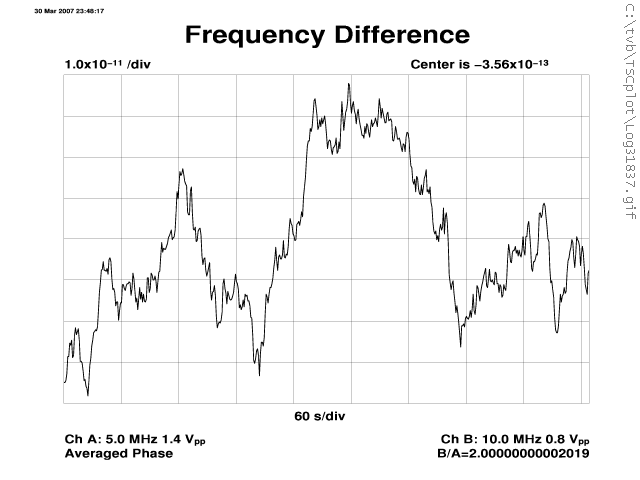 |
At tau one second, frequency stability (Allan deviation) is just under 2×10-12 rising to about 1×10-11 at 100 seconds and then falling nicely as one would expect with an well-engineered M12+ based GPS receiver. Performance is already down to 3×10-13 at 10k seconds. It would not be unreasonable to expect 1×10-13 or better stability for averaging times of a day.
The phase plot shows a time wander approaching 4 ns over a 10-minute duration, which seems a little on the high side. This wander graphically shows up statistically as the hump in the ADEV plot.
The frequency plot shows short-term noise on the order of 1×10-11 and mid-term wander on the order of 8 divisions of 1×10-11, or just under 1×10-10 over the 10-minute duration of the plot.
The GPS/OCXO cross-over point appears to be around 100 s. Under these testing conditions, this seems a little short; the GPS-locked Fury performs quite a bit worse than the free-running OCXO for quite a range of tau. Or perhaps it's exposing a limitation in the phase detector. More on this later.
The Fury 10 MHz output was compared at high-resolution against a laboratory atomic frequency standard and phase error samples taken at a 1Hz rate. The following are phase and frequency plots made from a full 100,000 seconds (about 28 hours) of raw data.
Raw phase data clearly showing a -8.63×10-12 offset in
reference frequency (not the GPSDO):
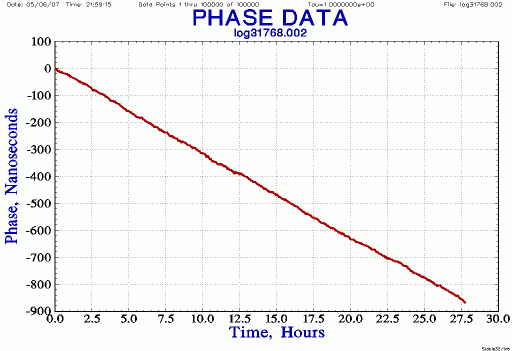
Removing the frequency offset and normalizing gives this residual phase plot:
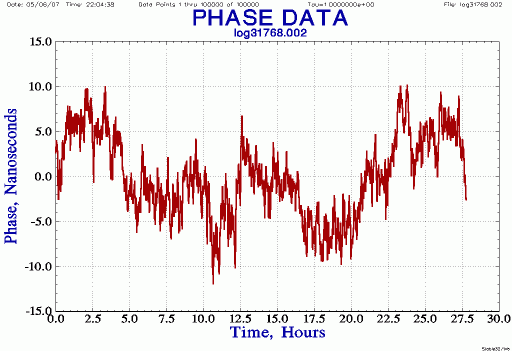
The above phase plot suggests the GPSDO stays on time to within ±10 ns over a day. Note that 1/86400 s = 1.16×10-5 s. So as a rule-of-thumb roughly 1 µs/day = 10-11, 100 ns/day = 10-12, 10 ns/day = 10-13, 1 ns/day = 10-14. This level of time wander, ±10 ns, is consistent with an M12+ based GPS receiver.
To look at the frequency domain, raw phase is converted to normalized frequency. Note frequency stability or accuracy measurements very much depend on the averaging time. A GPSDO is typically much more accurate in the long-term than it is stable in the short-term.
Converting phase to frequency with no averaging (1 second per point):
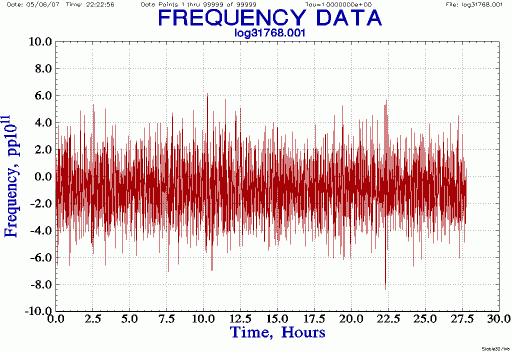
Same plot scale but with 10 second averages per point:
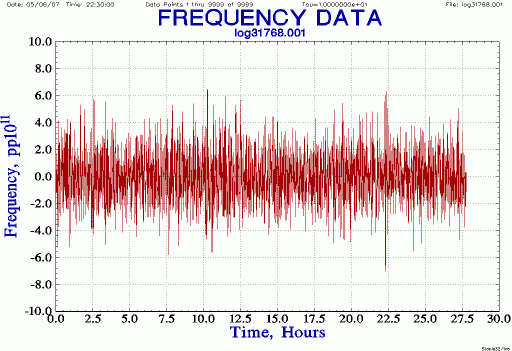
Same plot scale but with 100 second averages per point:
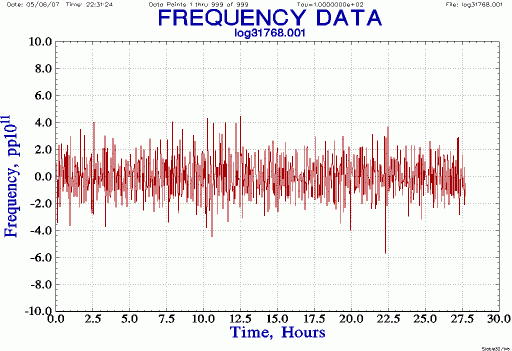
Same plot scale but with 1000 second averages per point:
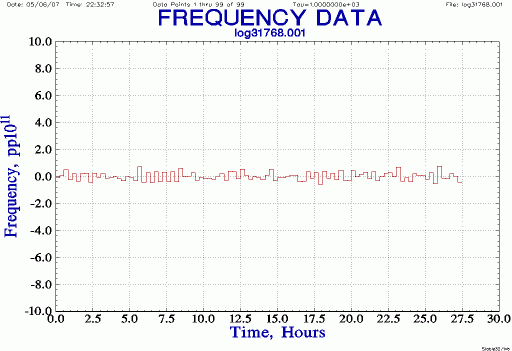
Also 1000 second averages per point but 10x zoomed scale:
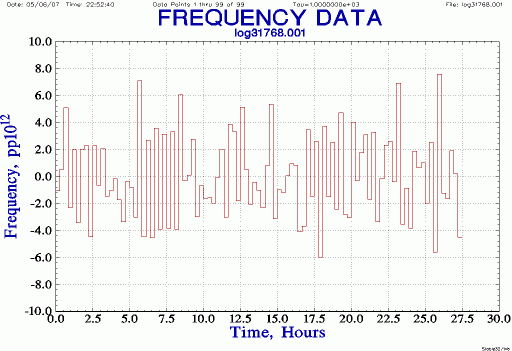
The above set of frequency plots show that 1, 10, even 100 second frequency averages are well under ±1×10-10 but significantly above ±1×10-11. Only with averaging on the order of 1000 seconds does frequency stability reach the 10-12 level.
Using the same data, here are calculated Allan deviation statistics. They agree, as expected, with the ADEV plot above.
Allan deviation (overlapping):
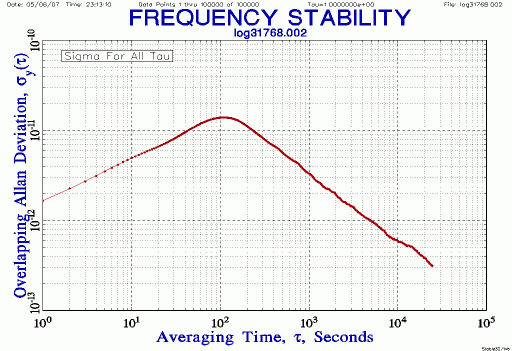
Allan deviation (overlapping & modified):
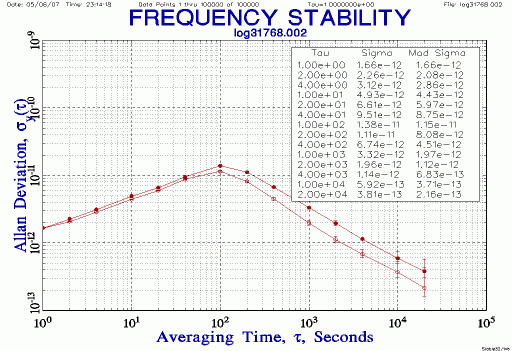
The Fury has an RS232 serial port and accepts a useful subset of HP SmartClock (e.g., 58503A, 58503B, Z3801A) SCPI commands. More on this later. Or see the Fury manual for details.
One word of caution: since the internal architecture of the Fury is different from the Z3801A some of the commands are emulations, i.e., rough or subjective approximations to the real thing. Use of these commands to compare the Fury with legacy HP receivers may lead to false conclusions. More on this later.
I'm sure you're curious so below is a short-term comparison between a Fury and a Z3801A:
| Fury, 1×10-11 per division | Z3801A, 1×10-11 per division |
 |
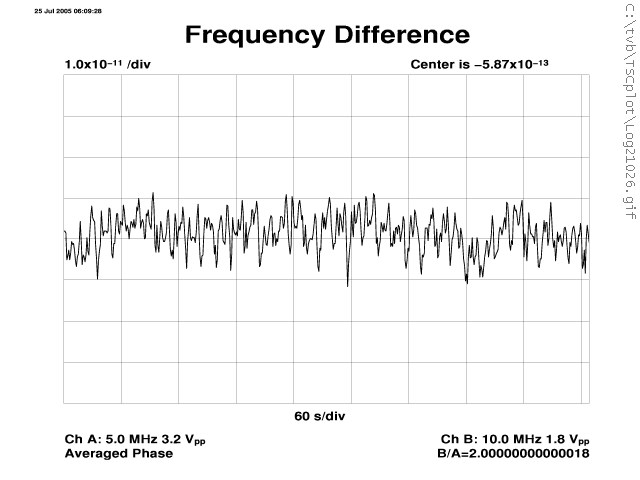 |
In case your browser doesn't render those plots well, here they are individually. First the Fury:
| Fury: 10-minute frequency plot, 1×10-11 per division |
 |
And then, using the same scale, one of my Z3801A:
| Z3801A: 10-minute frequency plot, 1×10-11 per division |
 |
The cleaner Z3801A frequency plot is likely due to its superior DAC/OCXO (many have ADEV in the mid 10-13 's; this one is ~1.5×10-12 for tau 10~100 seconds vs. the Fury 5~12×10-12). Note the Z3801A SmartClock is a 15 year old design, with a now ancient 8- or even 6-channel Motorola Oncore VP GPS receiver, without sawtooth correction (?), and designed for an era when GPS S/A was still in effect, none of which is a factor in short-term stability.
While I try to get a clean run lasting a full week or two, were are some plots after 324,000 seconds (= 90 hours = 3.75 days):
Reference frequency offset 8.67×10-12 removed; phase residuals (1 Hz samples):
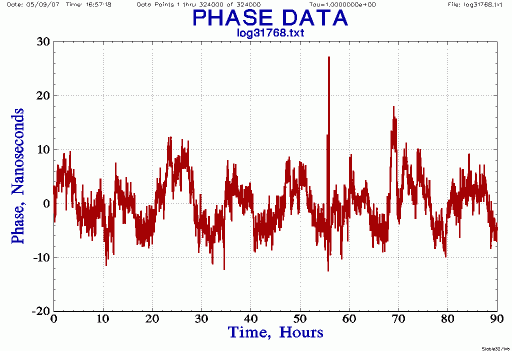
Frequency (1 Hz samples, no averaging):
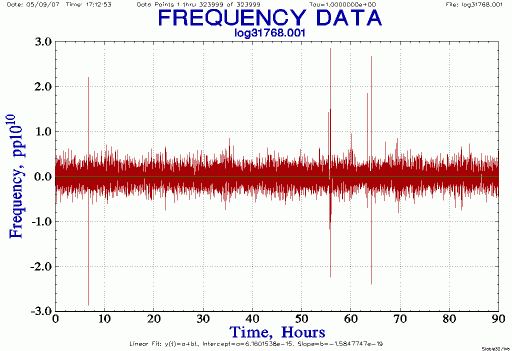
Stability (Allan Deviation, 1-2-4 decade tau):
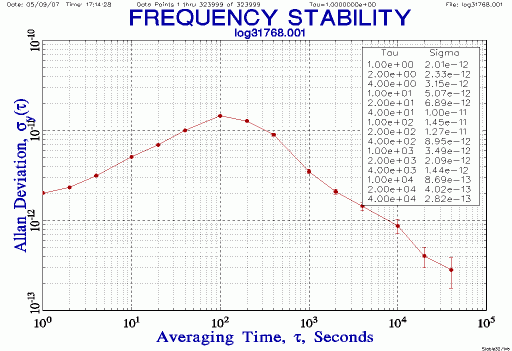
Stability (Overlapped ADEV, many tau):
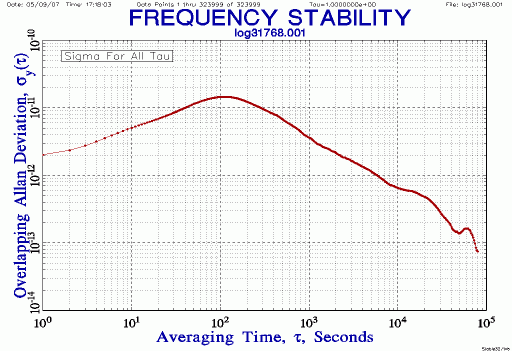
From the above stability plot we see the Fury GPSDO does in fact get down to 1×10-13 stability at tau 1 day.
The above phase plot shows some periodicity, approximately 12-hours in length, suggesting a GPS SV rather than an lab environmental issue. I'm not sure if this is related to GPS coverage, or an inaccurate auto-survey, or what. More on this later.
The phase plot also shows a large spike near hour 56. One of these may have been caused by a slight change in air-flow in the lab for a few minutes duration. It suggests a full environmental test is in order to explore how sensitive the Fury is to changes in temperature, or changes in temperature gradient, or temperature rate of change. I suspect the real world is quite different from tightly controlled laboratory conditions.
The frequency plot also has a few glitches, one of which matches the large phase disturbance.
Until I calibrate the reference oscillator consider this phase noise plot preliminary:
| Fury phase noise (actual results may be better than this plot) |
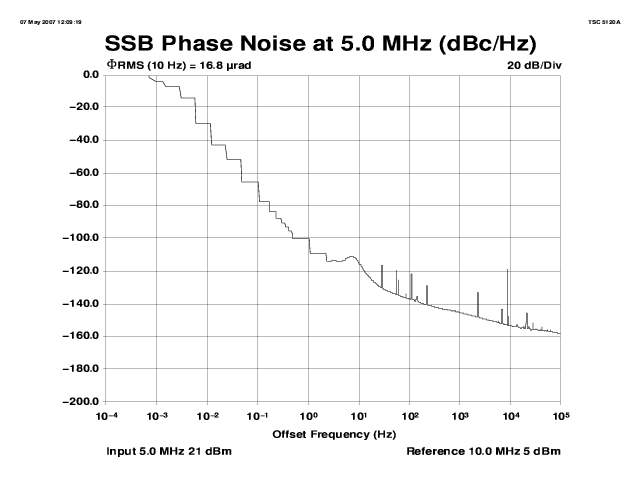 |
Oct 2007 -- A more detailed analysis of Fury GPSDO Phase Noise is now available.
The Fury is a current product rather than a piece of surplus gear or vintage museum piece, so I'll defer questions about pricing and availability to the Jackson Labs web site.
Under conditions of continuous GPS lock the Fury can honestly claim a frequency accuracy on the order of 1×10-11 short-term, 1×10-13 long-term, and a time consistency on the order of ±10 ns. Time accuracy (not tested) is a function of a host of fixed and variable, internal and external factors; without much effort one can usually claim a GPSDO like this is accurate to ±100 ns of UTC absolute.
The Fury does a good job making use of the inherent performance of the M12+. The MTI OCXO is well-matched to the other components. Under the ideal testing conditions here, the discipline algorithm seems properly implemented, although perhaps mistuned. Other aspects of Fury software could use some polishing.
The development of this product is an interesting case study. Mr. Jackson joined our time-nuts mailing list a year or two ago, not so much as a casual amateur like most of the members, but as an aggressive engineer entrepreneur. Thus rather than talk endlessly about design issues, he actually forged ahead and built a proprietary-design, commercial-quality GPSDO with generous coaching and testing assistance by members of the group. The choice of M12+ and SC-cut MTI oscillator was a good one, the DSP phase detector method proven, and the Fury works quite well.